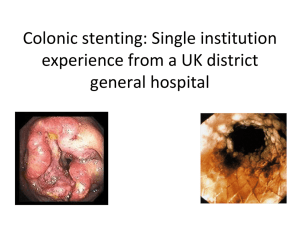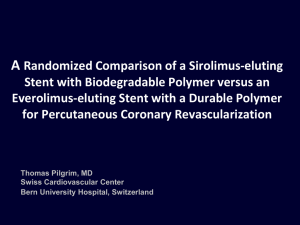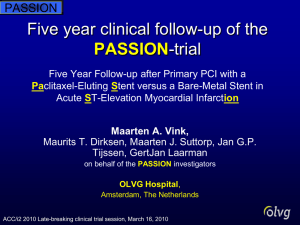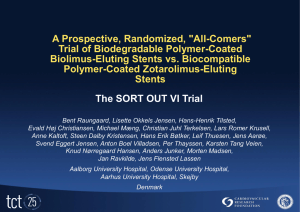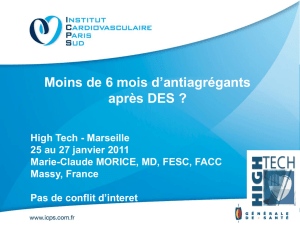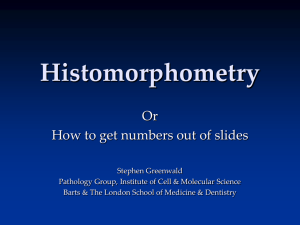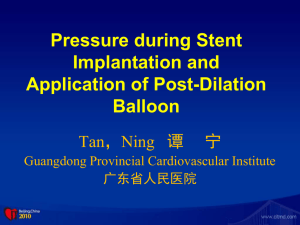Appendix
advertisement
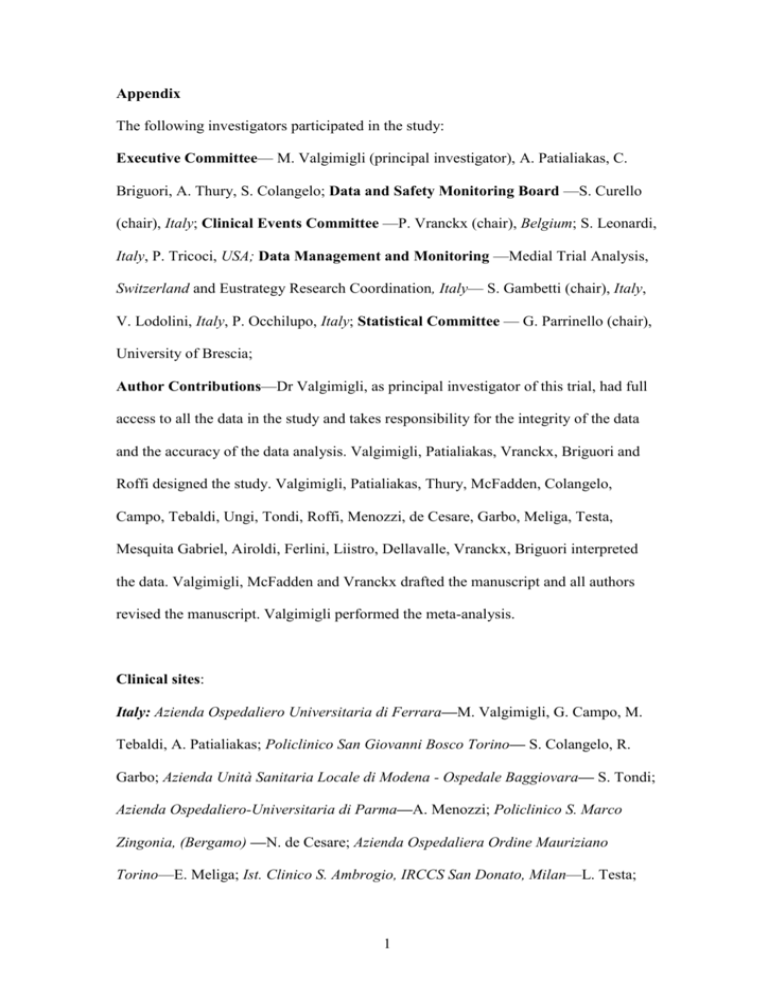
Appendix The following investigators participated in the study: Executive Committee— M. Valgimigli (principal investigator), A. Patialiakas, C. Briguori, A. Thury, S. Colangelo; Data and Safety Monitoring Board —S. Curello (chair), Italy; Clinical Events Committee —P. Vranckx (chair), Belgium; S. Leonardi, Italy, P. Tricoci, USA; Data Management and Monitoring —Medial Trial Analysis, Switzerland and Eustrategy Research Coordination, Italy— S. Gambetti (chair), Italy, V. Lodolini, Italy, P. Occhilupo, Italy; Statistical Committee — G. Parrinello (chair), University of Brescia; Author Contributions—Dr Valgimigli, as principal investigator of this trial, had full access to all the data in the study and takes responsibility for the integrity of the data and the accuracy of the data analysis. Valgimigli, Patialiakas, Vranckx, Briguori and Roffi designed the study. Valgimigli, Patialiakas, Thury, McFadden, Colangelo, Campo, Tebaldi, Ungi, Tondi, Roffi, Menozzi, de Cesare, Garbo, Meliga, Testa, Mesquita Gabriel, Airoldi, Ferlini, Liistro, Dellavalle, Vranckx, Briguori interpreted the data. Valgimigli, McFadden and Vranckx drafted the manuscript and all authors revised the manuscript. Valgimigli performed the meta-analysis. Clinical sites: Italy: Azienda Ospedaliero Universitaria di Ferrara—M. Valgimigli, G. Campo, M. Tebaldi, A. Patialiakas; Policlinico San Giovanni Bosco Torino— S. Colangelo, R. Garbo; Azienda Unità Sanitaria Locale di Modena - Ospedale Baggiovara— S. Tondi; Azienda Ospedaliero-Universitaria di Parma—A. Menozzi; Policlinico S. Marco Zingonia, (Bergamo) —N. de Cesare; Azienda Ospedaliera Ordine Mauriziano Torino—E. Meliga; Ist. Clinico S. Ambrogio, IRCCS San Donato, Milan—L. Testa; 1 IRCCS Multimedica Sesto San Giovanni Milano—F. Airoldi; Fondazione IRCCS Policlinico San Matteo, Pavia—M. Ferlini; San Donato Hospital, Arezzo—F. Liistro; Ospedali Riuniti ASL 17 – Savigliano—A. Dellavalle; Clinica Mediterranea di Napoli—C. Briguori; Ospedale delle Croci, Ravenna—M. Acquilina; Spedali Riuniti di Bergamo—G. Musumeci. Switzerland: University Hospital, Geneva—M. Roffi Portugal: Hospital de Santa Cruz Carnaxide Lisbon— H. M. Gabriel; Hungary: Cardiology Center, Szeged— A. Thury, I. Ungi; 2 PATIENTS SELECTION CRITERIA AND DURATION OF DUAL ANTIPLATELET THERAPY: Patients were eligible for recruitment if they were considered to be uncertain DES candidates based on 3 major inclusion criteria: 1) high bleeding risk and/or the presence of relative or absolute contraindications to long-term dual anti-platelet treatment and/or 2) high thrombosis risk due to systemic disorders or planned non-cardiac surgery and/or 3) low restenosis risk based on angiographic findings. Protocol mandated DAPT regimens, which were entirely based on inclusion criteria as detailed below. In patients with multiple inclusion criteria, DAPT duration was adapted as follows: bleeding risk status dominates thrombotic risk, which in turn dominates restenosis risk. High Bleeding Risk Criteria Patients were considered at high bleeding risk based on the presence of at least one of the following criteria: 1) Clinical indication for treatment with oral anticoagulants, including warfarin, dabigatran or other oral anticoagulant agents 2) Recent (in the preceding year) bleeding episode(s) which required medical attention 3) Previous bleeding episode(s) which required hospitalisation if the underlying cause has not been definitively treated (i.e. surgical removal of the bleeding source) 4) Age greater than 80 5) Systemic conditions associated with an increased bleeding risk (e.g. haematological disorders, including a history of or current thrombocytopaenia defined as a platelet count <100,000/mm3 (<100 x 109/L),, or any known coagulation disorder associated with increased bleeding risk 6) Documented anaemia defined as repeated haemoglobin levels <10 g/dl not due to acute and documented blood loss 7) Need for chronic treatment with steroids or non-steroidal anti-inflammatory drugs DAPT duration was set at 30 days in patients fulfilling at least one of the above reported high bleeding risk features. High thrombosis risk Criteria Patients were considered at high thrombosis risk based on the presence of at least one of the following criteria: 1) Allergy/intolerance to aspirin 2) Allergy/intolerance to available P2Y12 inhibitors 3) Planned surgery (other than skin) within 12 months of percutaneous coronary intervention (PCI). 4) Patient with cancers (other than skin) and life expectancy >1 year 5) Patients with systemic conditions associated with an increased risk of thrombosis (e.g., haematologic disorders and any known systemic conditions associated with a prothrombotic state including immunological disorders) Indefinite mono-therapy with aspirin or with one of the available P2Y12 inhibitor, including clopidogrel, prasugrel or ticagrelor was recommended in patients showing allergy/intolerance to aspirin or to any P2Y12 inhibitors, respectively. DAPT was protocol-mandated until surgical intervention in patients in patients with planned surgery whereas it was set at 6 to 12 months in the other patient groups at high thrombotic risk. Low Restenosis Risk Criteria 3 Patients were considered at low restenosis risk if use of a stent, less than 3.0 mm diameter, was not planned. Planned stent implantation to treat lesions in the left main coronary artery, saphenous vein grafts or in previously implanted stents were major exclusion criteria in this group. In addition, patients in whom, at the discretion of the treating physician, there was not clinical equipoise between BMS and DES (i.e. patients with diffuse three-vessel disease or complex bifurcation disease with planned bifurcation stenting or with Syntax score >33) were excluded from randomization. DAPT was set at 30 days for patients at low restenosis risk if presented a stable coronary artery disease phenotype at randomisation or at 6 to 12 months if indication to the index procedure was dictated by an unstable coronary artery disease phenotype including unstable angina, or myocardial infarction. Exclusion Criteria Any of the following: a) Pregnancy. Women of childbearing potential must have had a negative pregnancy test (urine or serum HCG), preferably <24 hours, but at a minimum within 7 days prior to randomisation. b) Subjects who were unable to give informed consent and/or were unwilling to undergo planned follow-up through 12 months. Randomization Procedure Allocation of study treatment was performed via a web-based interactive randomization system available at www.cardiostudy.it/zeus. Randomisation was achieved with use of a computer-generated random sequence, with a random block size, stratified according to the clinical site and the pre-defined criterion qualifying the eligible patient as an uncertain DES candidate. In case of multiple qualifying inclusion criteria, high bleeding risk features were pre-specified to dominate on high thrombotic risk characteristics, which, in turn dominate on low restenosis risk criteria. DAPT duration followed the same hierarchy. Statistical Analysis Duration of DAPT has been quantified in days of therapy from randomisation to first planned permanent discontinuation (i.e. when either the drug was stopped based on protocol recommendations or at the discretion of the treating physician with no intention to restart the treatment at a later date) and in terms of cumulative DAPT duration by adding DAPT days to first planned discontinuation in those patients who resumed DAPT during follow-up. Prespecified analysis of the primary end point was to be performed according to the pre-defined 3 major criteria qualifying patients for inclusion (i.e. high thrombosis or bleeding and low restenosis risk category), age, gender, presence of diabetes, clinical presentation at time of randomisation and intended DAPT duration: up 30 days or more. Estimation of the cumulative major adverse cardiovascular event rate was done with the Kaplan-Meier method, and events were compared by the log rank test. Hazard ratios (HRs) with 95% confidence intervals (CIs) were calculated using a proportional hazards model. The proportionality assumptions were checked by visual estimation after plotting the log Cumulative Hazard versus (log) time at follow-up after index procedure and by applying a test for non-proportional hazards using the Schoenfeld residuals. We performed a Cox-regression analysis with interaction testing to determine whether the effect of duration of dual antiplatelet therapy on the primary efficacy end point at 2 year was consistent across important prespecified subgroups. Interaction tests were done with likelihood-ratio tests of the null hypothesis that the interaction coefficient is zero. Subgroup Analysis As shown in Fig. 2, the treatment assignment and primary composite endpoint at 1 year proved to be consistent across the 8 prespecified subgroups, including gender, age, presence of diabetes, stable versus unstable coronary artery disease, protocol mandated duration of dual anti-platelet therapy up to 30 days versus longer, treatment of the left anterior descending artery, multivessel intervention and treatment of at least one complex (i.e. B2 or C type according to the ACC/AHA lesion classification) coronary artery lesion. Study Endpoint Definitions The primary patient oriented endpoint was all cause death, non-fatal MI, and target vessel revascularisation at 12 months. Each individual component was reported as such. 4 DEATH All deaths were considered cardiac unless an unequivocal non-cardiac cause could be established. Specifically, any unexpected death even in patients with coexisting potentially fatal non-cardiac disease (e.g. cancer, infection) was classified as cardiac. Cardiac death Any death due to immediate cardiac cause (e.g. MI, low output failure, fatal arrhythmia). Unwitnessed death and death of unknown cause were classified as cardiac death. This included all procedure related deaths including those related to concomitant treatment. MYOCARDIAL INFARCTION Peri-procedural PCI (< 48 hours) The development of a myocardial infarction (MI) within 48 hours after completion of PCI was defined as CK-MB ≥3 times the upper limit of normal, whether or not accompanied by chest pain and/or ECG changes, or new pathological Q waves (≥0.04 seconds in duration in two or more contiguous leads). An MI in patients with CK-MB elevation prior PCI was defined by at least a 25% decrease in CK-MB from a prior peak level, followed by a new increase of at least 50% above the preceding valley and ≥3 times the upper limit of normal Periprocedural MI during CABG (within 7 days after CABG) In patients undergoing coronary artery bypass surgery during the study follow-up period, a periprocedural MI was diagnosed by a rise in the CK-MB level of five times the upper limit of normal. Peri-procedural Myocardial Infarction in the setting of evolving MI: 1) If the peak total CK (or CK-MB) from the index infarction had not yet been reached: recurrent chest pain lasting >20 minutes (or new ECG changes consistent with MI) AND the peak CK-MB (or CK in absence of CK-MB) level measured within 24 hours after the event is elevated by at least 50% above the previous level. 2) If the elevated CK-MB (or CK) levels from the index infarction were falling or had returned to normal within 24 hours post index PCI: EITHER a new elevation of CK-MB >3 x ULN within 24 hours post index PCI if the CK-MB level had returned to <ULN OR a rise by >50% above the previous nadir level if the CK-MB level had not returned to <ULN. Spontaneous MI (adapted from ESC/ACC guidelines JACC 2000) Either one of the following criteria satisfied the diagnosis for an acute, evolving or recent MI: 1) Typical rise and gradual fall (Troponin) or more rapid rise and fall (CK-MB) of biochemical markers of myocardial necrosis with at least one of the following: a) Ischaemic symptoms b) Development of pathologic Q waves on the ECG c) ECG changes indicative of ischaemia (ST segment elevation or depression); 2) Pathologic findings of an acute MI. Q-wave MI Development of new pathological Q waves in 2 or more contiguous leads with or without elevated postprocedure CK or CK-MB levels. REVASCULARISATION TARGET LESION (TL) The target lesion was defined as the stented segment including the adjacent margin 5 mm proximal and distal to the stent. TARGET LESION REVASCULARISATION (TLR) TLR was defined as any repeat percutaneous intervention of the target lesion or bypass surgery of the target vessel to treat restenosis or other complication of the target lesion. All TLRs were classified prospectively as either clinically or not clinically indicated by the investigator prior to the reintervention. They were also classified retrospectively by the Clinical Event Committee using angiographic analysis provided by an independent core laboratory TARGET VESSEL (TV) The target vessel was defined as the entire major coronary vessel proximal and distal to the target lesion including upstream and downstream branches and the target lesion itself. (For example: if the original lesion was the first obtuse marginal branch, the target vessel included the left main coronary artery, the circumflex coronary artery and its branches). Note: in three-vessel treatment every repeat revascularisation becomes TVR. 5 TARGET VESSEL REVASCULARISATION (TVR) TVR was defined as any repeat percutaneous intervention or bypass surgery of the target vessel (as defined above). Clinically Indicated: A revascularisation (TLR/TVR) was considered clinically indicated if angiography at follow-up showed a percent diameter stenosis ≥50% (QCA) and if one of the following occurred according to Clinical Event Committee members: 1) History of recurrent angina pectoris presumably related to the target vessel. 2) Objective signs of ischaemia at rest (ECG changes) or during exercise test (or equivalent) presumably related to the target vessel. 3) Abnormal results of any invasive functional diagnostic test documented in the Case Report Form (e.g. Doppler flow velocity reserve, fractional flow reserve). A TLR/TVR for a diameter stenosis ≥70% (worst view? on QCA) in the absence of ischaemic signs or symptoms was also considered clinically indicated. Not Clinically indicated TLRs/TVRs were reinterventions for: 1. all stenoses <50% (diameter stenosis by QCA) in the presence or absence of ischaemic signs or symptoms; 2. all stenoses ≥50% but <70% (diameter stenosis by QCA) without ischaemic signs or symptoms. Clinically indicated: documented provisional decision to re-intervene based on clinical symptoms and/or results of non invasive functional testing, before any coronary imaging. NON TARGET LESION REVASCULARISATION (nonTLR) Any revascularization in a lesion other than the target lesion is considered a non-TLR. NON TARGET VESSEL REVASCULARISATION (nonTVR) Any revascularization in a vessel other than the target vessel is considered a non-TVR. D. STENT THROMBOSIS Stent Thrombosis was reported as a cumulative value at the different time points and with the different separate time points. Time 0 is defined as the time point after the guiding catheter has been removed and the patient leaves the Cathlab. Timing: Acute stent thrombosis(*): 0 . 24 hours post stent implantation Subacute stent thrombosis(*): >24 hours . 30 days post stent implantation Late stent thrombosis: >30 days-1 year post stent implantation Very late stent thrombosis: >1 year post stent implantation (*) acute/subacute can also be replaced by early stent thrombosis. Early stent thrombosis (0-30 days). We recognized three categories of evidence in defining stent thrombosis: 1) Definite 2) Probable 3) Possible 1. Definite (was considered either by angiographic or pathologic confirmation). Angiographic confirmation of stent thrombosis is considered to have occurred if: 1) Thrombolysis In Myocardial Infarction (TIMI) flow was: a) TIMI flow grade 0 with occlusion originating in the stent or in the segment 5 mm proximal or distal to the stent region in the presence of a thrombus. b) TIMI flow grade 1, 2, or 3 originating in the stent or in the segment 5mm proximal or distal to the stent region in the presence of a thrombus. AND at least one of the following criteria, had been fulfilled within a 48 hours time window: 2) New onset of ischaemic symptoms at rest (typical chest pain with duration >20 minutes) 3) New ischaemic ECG changes suggestive of acute ischaemia 4) Typical rise and fall in cardiac biomarkers 6 The incidental angiographic documentation of stent occlusion in the absence of clinical signs or symptoms was not considered a confirmed stent thrombosis (silent occlusion). Non-occlusive thrombus: Intracoronary thrombus was defined as a (spheric, ovoid or irregular) non-calcified filling defect or lucency surrounded by contrast material (on three sides or within a coronary stenosis) seen in multiple projections, or persistence of contrast material within the lumen, or a visible embolization of intraluminal material downstream. Occlusive thrombus: A TIMI 0 or TIMI 1 intra-stent or proximal to a stent up to the most adjacent proximal side branch or main branch (if originating from the side branch). Pathologic confirmation of stent thrombosis: Evidence of recent thrombus within the stent determined at autopsy 2) Probable: Probable stent thrombosis was defined as: 1) Any unexplained death within the first 30 days. 2) Irrespective of the time after the index procedure any myocardial infarction (MI), which was related to documented acute ischaemia in the territory of the implanted stent without angiographic confirmation of stent thrombosis and in the absence of any other obvious cause. 3) Possible: Possible stent thrombosis was defined as any unexplained death following intracoronary stenting until the end of the follow-up period. 7 Figure 1: Patient Flow Chart BMS denotes bare-metal stent, POBA plain balloon angioplasty, ZES: zotarolimus-eluting stent. 8 Figure 2: Cumulative Duration of Dual Anti-platelet therapy The cumulative frequency curve for the cumulative duration of dual anti-platelet therapy (DAPT) in each stent group during follow-up is shown. The cumulative DAPT duration has been quantified in days of therapy from randomization to first planned permanent discontinuation plus DAPT days up to 365 days in those patients who resumed DAPT during follow-up. 9
